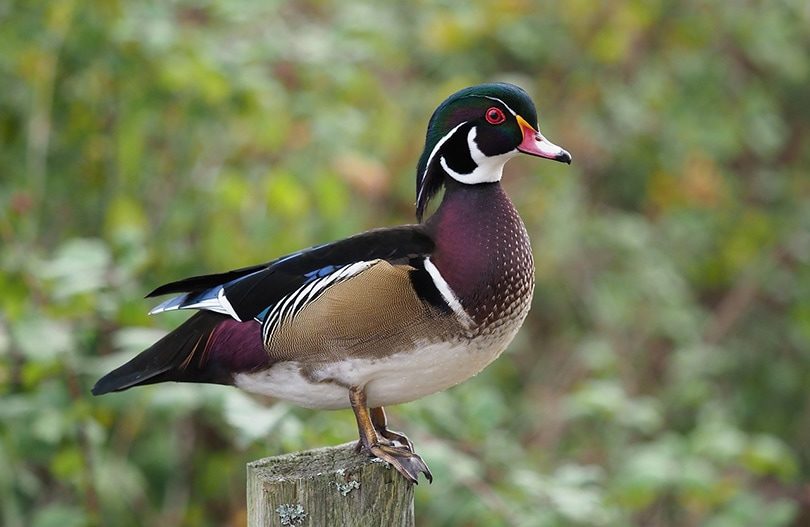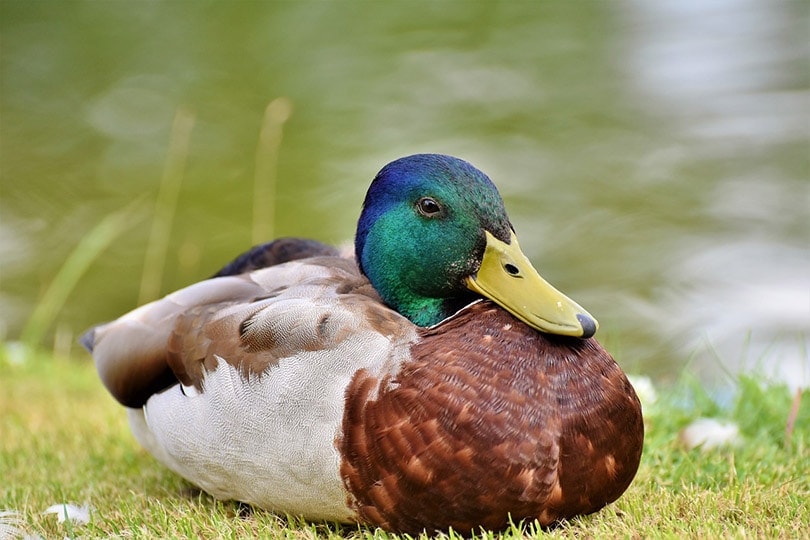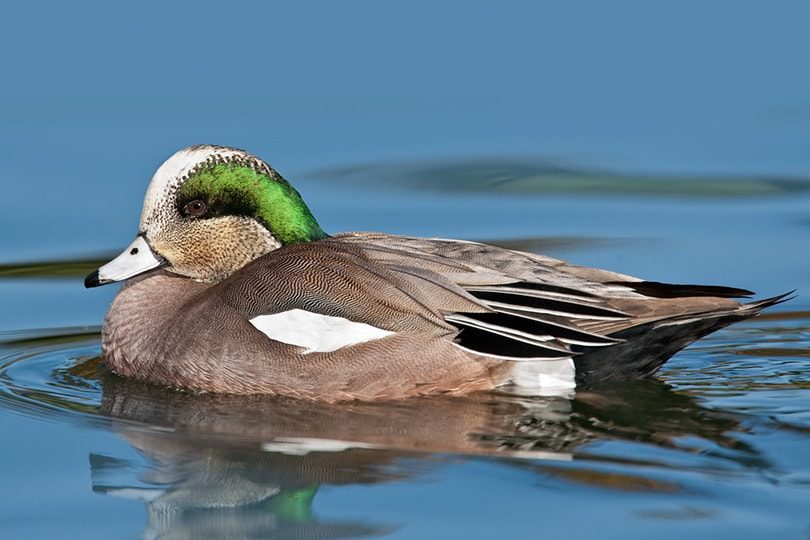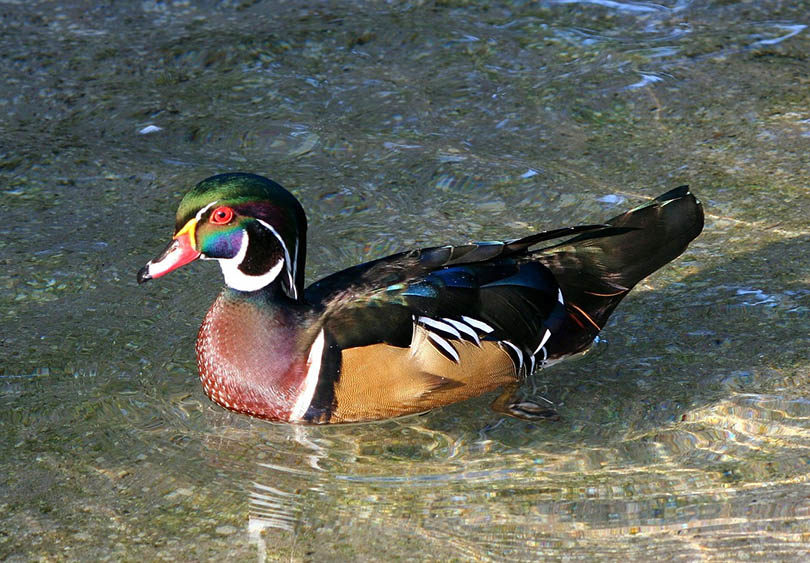7 Ducks With Green Heads (With Pictures for Identification)
Last Updated on

Mallards are the duck breed commonly known for having bright, iridescent green heads — specifically, male Mallards in the breeding season. But several other duck breeds have green heads too! All ducks with green heads are males, known as drakes, and often have a far more colorful plumage than females overall.
After breeding season, males typically molt and lose most of their colorful feathers, at which point, some of them closely resemble the females of their breed. During the breeding season, though, males are eye-catching with their gorgeous green heads, and it is helpful to be able to identify exactly which duck breed you’ve spotted.
Let’s look at seven different ducks that have green heads!

The 7 Different Ducks With Green Heads
1. Mallard

| Scientific Name: | Anas platyrhynchos |
| Length: | 19.7 – 25.6 inches |
| Wingspan: | 32.3 – 37.4 inches |
The Mallard is a large duck that breeds throughout North and South America and prefers to live in wetlands in small flocks. The males have bright green iridescent heads, with grey on their wings and bellies, while females typically have brown-speckled plumage. Both males and females have iridescent blue feathers on their wings. Mallards are known for flying extremely fast, hitting up to 70 miles an hour at times, and they can fly almost vertical!
2. Greater Scaup

| Scientific Name: | Aythya marila |
| Length: | 15 – 22 inches |
| Wingspan: | 28 – 31 inches |
The Greater Scaup, commonly known as the “Bluebill” duck in the U.S., is a mid-sized duck with a gorgeous dark black head. During the breeding season, an iridescent green sheen can be seen on the males’ heads, with white and black backs and bellies. Females are typically brown with distinctive white ovals around their bills. They are known for being the only circumpolar diving duck species and are long-lived ducks that have been recorded living for up to 20 years in the wild.
- See also: Do Ducks Migrate? Where Do They Go?
3. Common Goldeneye

| Scientific Name: | Bucephala clangula |
| Length: | 19.7 – 25.6 inches |
| Wingspan: | 32.3 – 37.4 inches |
Common Goldeneye Ducks are medium-sized ducks with distinctively large heads. The males have mostly white bodies, black wings, and iridescent dark green heads that appear almost black. Females have brown heads with grey bodies and a mostly black beak with a tip of yellow at the very end. These ducks are known to be aggressive and territorial birds, with males performing elaborate courtship displays, including throwing their heads back, kicking the water, and loud calling.
4. American Wigeon

| Scientific Name: | Mareca americana |
| Length: | 16 – 23 inches |
| Wingspan: | 33 inches |
American Widgeons are medium-sized, compact ducks with a round head, short neck, and small bill. The male has a brown-grey head with a bright green stripe behind the eye and a distinctive white cap, with brown bodies and black-tipped wings. Females have a brown body with a brown-grey head and distinctive dark smudge around their eyes and a black-tipped bill. Widgeons are fast flyers and can reach speeds of up to 35 miles an hour!
5. Green-winged Teal

| Scientific Name: | Anas crecca |
| Length: | 12 – 15 inches |
| Wingspan: | 20 – 23 inches |
The smallest dabbling duck found in North America, the Green-winged Teal is a common and widespread species that can be found almost everywhere on the continent. Males have mottled black and white bodies with a chestnut brown head and a distinctive green stripe behind the eye, while females have a similar appearance but with a long horizontal white stripe on their sides. They are among the fastest flying game birds behind Mallard ducks, capable of speeds of up to 60 miles per hour.
- Related: Where Do Ducks Sleep?
6. Northern Shoveler

| Scientific Name: | Spatula clypeata |
| Length: | 17 – 20 inches |
| Wingspan: | 27 – 33 inches |
The Northern Shoveler is easily identifiable by the long, spoon-shaped bill that gives them their name, as well as their unique coloring. Males have a bright white chest, rusty brown sides, and a bright green head, while females have gorgeous mottled brown plumage and a large orange spoonbill. Northern Shovelers are found throughout the U.S. and in Europe, Africa, and India. They also have comparatively long lifespans and have been known to live up to 16 years in the wild.
7. Wood Duck

| Scientific Name: | Aix sponsa |
| Length: | 18 – 21 inches |
| Wingspan: | 26 – 29 inches |
One of the most beautiful duck species, the Wood Duck gets their name from their preference to nest and perch in woodlands and is highly adept at flying through densely wooded areas. Males have a beautiful green crested head, a chestnut brown chest, and unique brown, tan, white, and black markings on the rest of their body. Females are also beautiful, with a slightly crested head with a white teardrop surrounding the eye, mostly brown body, and gorgeous blue speculum patches on their wings. Wood Ducks were hunted almost to extinction at one stage, but there are now thought to be over a million wild Wood Ducks in the United States.
Featured Image Credit By wam17, Pixabay
About the Author Robert Sparks
Robert’s obsession with all things optical started early in life, when his optician father would bring home prototypes for Robert to play with. Nowadays, Robert is dedicated to helping others find the right optics for their needs. His hobbies include astronomy, astrophysics, and model building. Originally from Newark, NJ, he resides in Santa Fe, New Mexico, where the nighttime skies are filled with glittering stars.
Related Articles:
Monocular vs Telescope: Differences Explained (With Pictures)
How to Clean a Refractor Telescope: Step-by-Step Guide
How to Clean a Telescope Eyepiece: Step-by-Step Guide
How to Clean a Rifle Scope: 8 Expert Tips
What Is a Monocular Used For? 8 Common Functions
How to Clean a Telescope Mirror: 8 Expert Tips
Brightfield vs Phase Contrast Microscopy: The Differences Explained
SkyCamHD Drone Review: Pros, Cons, FAQ, & Verdict
